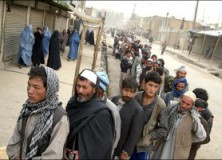Balancing Democracy Promotion and the Global War on Terror in Pakistan — Don Rassler

INTRODUCTION:
Soon after the GWOT began, President George W. Bush launched Washington’s freedom agenda: a strategy of global democracy promotion to augment America’s GWOT hard power efforts. In this context, the administration hoped that military might would decapitate al Qaeda leadership and disrupt terrorist networks, while democracy promotion would dissuade terrorist sympathizers and win local hearts and minds, thus preventing the emergence of terrorist safe havens or conditions conducive to the radicalization of local populations. The two mutually reinforcing policies, it has been argued, would complement each another to ensure success throughout the various stages of America’s new war. However, the record of U.S. engagement with Pakistan illustrates that both strategies have not been pursued with equal vigor nor have they garnered equivalent support. Of the two—GWOT and democracy promotion—the Bush administration has heavily favored and prioritized the former in Pakistan.
STRATEGY:
The U.S. government’s Pakistan strategy since 9/11 has been reactionary. Instead of developing comprehensive, integrated strategy, the Bush administration has excessively relied on President Pervez Musharraf and the Pakistani military to implement American aid and achieve U.S. goals—largely focused on counterterrorism. The general insufficiency of plans and/or procedures to coordinate the multiple objectives of America’s GWOT and democracy promotion agendas has impeded Washington’s efforts to leverage all elements of national power.
INTEGRATED ELEMENTS OF NATIONAL POWER:
Despite the Bush administration’s efforts to improve integration, especially using newly established coordinating mechanisms such as the National Counterterrorism Center and the Advisory Commission on Democracy Promotion, the United States’ counterterrorism and democracy promotion strategies in Pakistan have been poorly coordinated among U.S. departments and agencies. The United States has done an even poorer job of balancing the priorities of these strategies and fusing their multiple objectives and pathways. Significant disagreements regarding the direction of America’s Pakistan policy have existed not only within the administration, but also within the Department of Defense (DOD), as well as between DOD components and the State Department and Central Intelligence Agency. Scholars have also noted the lack of communication and coordination “between different parts of the U.S. government, such as the executive branch and the Congress or the civilians and military…”
EVALUATION:
The absence of a counterterrorism body authorized to direct all relevant elements of national power and the lack of a comprehensive plan to achieve U.S. national security goals in Pakistan hindered America’s GWOT efforts. The nonexistence of aid architecture, the delay in establishing a mechanism charged with coordinating U.S. democracy promotion activities, the insufficiency of plans, the limited Pakistan experts in the proper offices, and the lack of a common definition of democracy or understanding of what constitutes a democracy program contributed to the U.S. government’s lackluster democracy promotion activities within Pakistan. A failure to balance the priorities and relative funding levels of U.S. programs in Pakistan resulted from the prioritization of GWOT over America’s democracy promotion agenda. Washington’s preoccupation with GWOT activities and the primary government institutions it has relied upon to implement its strategy in Pakistan has inadvertently helped to ensure that the majority of U.S. assistance would be military in nature; channeled through the Department of Defense to the Pakistani military.
RESULTS:
The cost of insufficient strategy development and coordination has been an entrenched, emboldened, and strengthened terrorist adversary; an escalation in the level of violence within Pakistan (that as of mid-2008 shows no sign of abating); the diminished power (and eventual ousting) of President Musharraf—the cornerstone of U.S. policy; and a Pakistani public ever more suspicious of U.S. intentions.
CONCLUSION:
Pakistan will likely remain central to U.S. efforts to eliminate the threat posed by al Qaeda and its affiliates in the short-term and counter the jihadist ideology used to recruit and indoctrinate terrorist sympathizers in the long-term. In addition, democracy promotion—or at least a derivative of the U.S. government’s current democracy agenda—will likely remain an essential foreign policy objective, as well as an underlying theme of American national security decision-making. However, from 2001 to the present, the U.S. government has been insufficiently organized to fuse the strategy demands of its GWOT and democracy promotion policies in Pakistan. Despite some successes in the counterterrorism realm, Washington has been unable to balance, through funding or implementation, the various objectives of its democracy promotion and GWOT strategies.